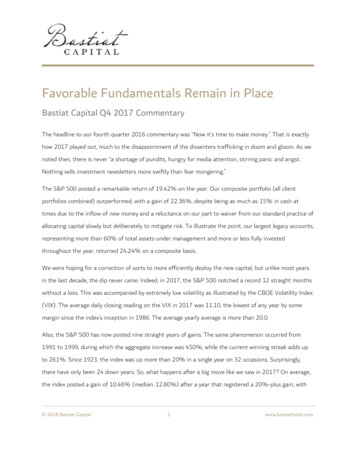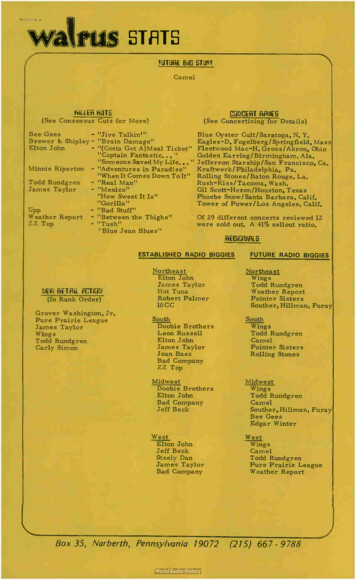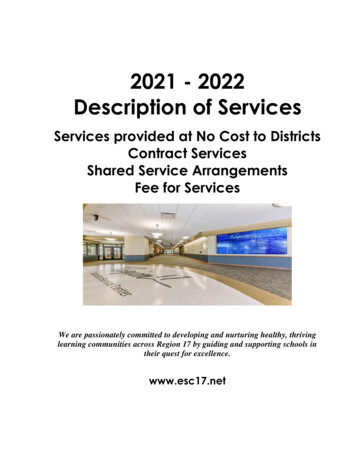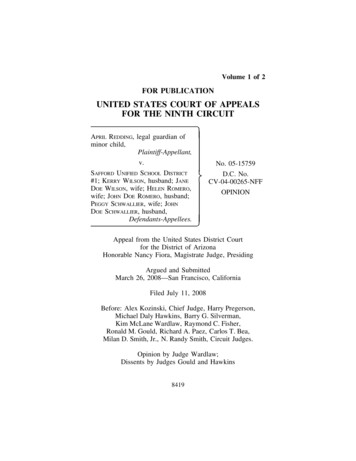
Transcription
Favorable Fundamentals Remain in PlaceBastiat Capital Q4 2017 CommentaryThe headline to our fourth quarter 2016 commentary was “Now it’s time to make money.” That is exactlyhow 2017 played out, much to the disappointment of the dissenters trafficking in doom and gloom. As wenoted then, there is never “a shortage of pundits, hungry for media attention, stirring panic and angst.Nothing sells investment newsletters more swiftly than fear mongering.”The S&P 500 posted a remarkable return of 19.42% on the year. Our composite portfolio (all clientportfolios combined) outperformed, with a gain of 22.36%, despite being as much as 15% in cash attimes due to the inflow of new money and a reluctance on our part to waiver from our standard practice ofallocating capital slowly but deliberately to mitigate risk. To illustrate the point, our largest legacy accounts,representing more than 60% of total assets under management and more or less fully investedthroughout the year, returned 24.24% on a composite basis.We were hoping for a correction of sorts to more efficiently deploy the new capital, but unlike most yearsin the last decade, the dip never came. Indeed, in 2017, the S&P 500 notched a record 12 straight monthswithout a loss. This was accompanied by extremely low volatility as illustrated by the CBOE Volatility Index(VIX). The average daily closing reading on the VIX in 2017 was 11.10, the lowest of any year by somemargin since the index’s inception in 1986. The average yearly average is more than 20.0.Also, the S&P 500 has now posted nine straight years of gains. The same phenomenon occurred from1991 to 1999, during which the aggregate increase was 450%, while the current winning streak adds upto 261%. Since 1923, the index was up more than 20% in a single year on 32 occasions. Surprisingly,there have only been 24 down years. So, what happens after a big move like we saw in 2017? On average,the index posted a gain of 10.46% (median: 12.80%) after a year that registered a 20%-plus gain, with 2018 Bastiat Capital1www.bastiatfunds.com
Bastiat Capital Q4 2017 Commentarypositive returns more than two-thirds of the time. In other words, history tells us that there is a 66%probability the market will again be positive at the end of 2018 and that the gain could be more than10%. It gets better because historical returns of the S&P 500 show that on five different occasions whenthe index returned 20%, it was followed by another 20% year, and for one of the five, the 20% returnslasted another four years. This is the risk that market-timers face; if their timing is wrong, theconsequences are harsh.On October 16, 2008, Warren Buffett wrote, in a New York Times op-ed that, “I can’t predict the shortterm movements of the stock market I haven’t the faintest idea as to whether stocks will be higher orlower a month—or a year—from now. What is likely, however, is that the market will move higher, perhapssubstantially so, well before either sentiment or the economy turns up. So, if you wait for the robins, springwill be over.”We do expect a weak January as investors take profits following last year’s super-sized returns. Once theselling stops and indicators confirm continued economic growth, the market should once again, as itusually does, reach new record highs. Recall, the S&P 500 kicked off in 2016 by falling 8% over its first 10trading days, its worst opening period in history. After 28 trading days, the index was down a little over 10%, again marking its worst start in history. This pattern could repeat itself. But long-term investorsought not to be phased by the volatility. Volatility is not a risk; it is the source of future returns.Also, keep in mind that most sell-offs are brief. Since 1923, the S&P 500 has experienced 47 correctionsof between 5% and 9.9%. Measured from peak to trough, they lasted on average one month, and themarket fully recovered after two months. We have seen 17 pullbacks that exceeded 10% but were limitedto 19.9%. In these instances, the decline lasted on average five months, and it took another four monthsto fully recover. A severe but not catastrophic drop of between 20% and 40% occurred six times and tookon average 10 months to bottom, with another 12 months to recover fully. We have seen three so-calledmega-meltdowns of more than 40%. These are the ones that require extraordinary nerve and patience.They last on average 23 months, and the market takes close to five years for a full recovery, at which point,if history is any indication, investors can expect the S&P 500 to double before another substantialpullback. 2018 Bastiat Capital2www.bastiatfunds.com
Bastiat Capital Q4 2017 CommentaryFour market strategists tracked by Bloomberg project that the S&P 500 will finish above 3,000, even ashigh as 3,100, which calls for a 16% gain on the year. On the other hand, Bloomberg polled their regularcohort of Wall Street analysts who appear less bullish. Their consensus S&P 500 price target for the endof 2018 stands at 2,854, which would mean a gain of roughly 6%. Over the past nine years, these analystshave underestimated actual returns seven times.A Year AgoIn last year’s commentary, we quoted, Raymond James Financial Chief Investment Strategist Jeffrey Saut,who argued that a cut in the corporate tax rate to 15% “could prove to be difficult,” but even at a tax rateof 25%, the S&P 500 earnings estimate for 2017 would be approximately 144. A 17 P/E would give aprice target for the S&P 500 of roughly 2,450 by the end of 2017, nearly a 10% increase.As Saut’s bullishness was vindicated, and with the final corporate tax cut coming in at 21% in the billpassed by Congress at the end of the year, it is worth finding out what he thinks now. "I would expect2018 to be an almost repeat of 2017, Saud recently told an interviewer. “People are still wayunderinvested. Earnings are starting to come in better than expected. And with the tax reform, andespecially the corporate tax cuts, I think earnings are going to continue to surprise on the upside.”The Tax BillA sorehead television host told viewers that their taxes are going up to give major corporations an“embarrassing amount of money.” The unpalatable fact is that four out of every five taxpayers will see theirtaxes go down. Several major corporations embraced the tax cuts with announcements of increased wagesand bonuses, which most rational people would consider good news, but which our host offered as proofthat the tax bill is a disaster. As soon as an issue is politicized, common sense is the victim.The smart folk at Bloomberg News, a more“As soon as an issue is politicized,common sense is the victim.”reliable source, examined the impact of the newtax code on eight families: 2018 Bastiat Capital3www.bastiatfunds.com
Bastiat Capital Q4 2017 Commentary(1) The Multimillionaires in New York: Under the current law their effective tax rate is 30.51%. Theywill now pay 31.19%. Oops, the rich are paying more, not a whole lot more, but it contradicts thepropaganda filling our email inboxes and what we hear on television;(2) The Second-Home Scenario in California with a primary residence in Malibu and a second home inLake Tahoe. Oops, another example that undermines the media’s disinformation campaign. Theireffective tax rate goes up from 26.77% to 27.24%, but again, small potatoes in the overallcontext of their income and wealth;(3) Small Business Owner in Pittsburgh: Wowzers, do we have a happy bunch of people in Pittsburgtoday!? Their effective tax rate goes down from 18.69% to 11.58%;(4) The Suburban Family in Westchester (could be neighbors to the Clintons, although this family’sgross income is “only” 275,000). Their effective rate goes down from 17.43% to 15.10%, a mere 6,000 “savings,” which a TV pundit will no doubt characterize as a tax break for the super-rich;(5) Single in Manhattan and earning 130,000 will now be paying tax at an effective rate of 16.90%,down from the current 18.57%;(6) Married in Austin and earning 100,000: Here’s a big break for the “poor,” but don’t tell the media.Their effective tax rate comes down from 11.28% to 8.74%;(7) Median Income Family in Oregon earning 58,000 will see their effective tax rate come down from8.01% to 6.38%, but still contributes 3,699 a year toward our bloated defense budget. Cut thedefense budget and give these wage-earners all a tax holiday is what we say; and(8) Renting in Milwaukee: A couple with one child earning 40,000 pay 515 under the current taxcode will now receive a tax refund (an enhanced child tax credit) of 400.An Inconvenient TruthNow, to divulge a secret the media entirely misses. Take the couple in Milwaukee, who earn 40,000 andostensibly pay no taxes. In fact, properly analyzed, they pay 15.3% ( 6,120) in stealth taxes, in the form ofpayroll taxes (these are technically paid 50/50 by the employee and the employer, but it’s reasonable toview the employer contribution as coming out of the employee’s pocket). For someone barely scraping by, 6,120 is a ton of money! Our family in Milwaukee earning 40,000 is responsible for adding 6,120 tothe Treasury in return for a 400 child tax credit! 2018 Bastiat Capital4www.bastiatfunds.com
Bastiat Capital Q4 2017 CommentaryFor those who argue that the payroll tax is not a tax becausethe money is “set aside” for retirement purposes, we have abridge in Brooklyn on offer at a bargain price. If today's retireeshad paid their social security contributions and those of theiremployer in the S&P 500 over the past 40 years, they wouldhave had at least 1.0 million to 1.5 million in their retirementaccounts today, depending on their salary levels. The average“For those who argue that thepayroll tax is not a tax becausethe money is “set aside” forretirement purposes, we havea bridge in Brooklyn on offerat a bargain price.”monthly social security check is 1,350.The families in Milwaukee and Oregon should be allowed to deposit their payroll taxes in two or threedesignated ETFs, to remain untouched until they reach the age of, say, 67, and then only in annualwithdrawals of, say, 5% of capital on hand. A small part of the monthly contribution could go to aninsurance company that would provide them virtually unlimited healthcare, more than matching whatMedicare has to offer, on retirement. Now that would be real tax reform for the not-so-well-off, or poorTake this all one step further. There are some dire predictions about massive budget deficits awaiting us incoming years as a result of “all these irresponsible tax breaks for the rich.” Does that concern our“honorable members of parliament?” Not in the least. They have a card up their sleeve. Don’t call usNostradamus if this all pans out. It seems a logical progression from the way they wheel-and-deal inWashington. Within the next three years (unless tax revenues balloon), payroll taxes will go up by about3%, perhaps not equally split between employers and employees. We suspect employers will have tocontribute, say, 2.45% and employees 0.55%. In addition, a means test will be applied and taxpayers witha net worth in excess of, say, 5 million, will not be entitled to any benefits, or perhaps only to Medicare.As Margaret Thatcher always argued: “Socialists eventually run out of other people’s money.”Bastiat on the BeebOn November 23, in an interview with BBC World Service, I pointed out that Apple was paying all thetaxes it was legally obligated to pay. This was the quote that the BBC chose to use following an hour-longinterview recorded a week earlier. 2018 Bastiat Capital5www.bastiatfunds.com
Bastiat Capital Q4 2017 CommentaryFor the record, what I told the BBC did not fit“ though the so-called “rich” ownApple stock, so do tens of millions ofgovernment workers at the federal,state and local levels.”their narrative, namely, that corporations shouldbe milked for all they are worth. My first andmost important point was that though the socalled “rich” own Apple stock, so do tens ofmillions of government workers (firefighter andteachers, for example) at federal, state and local levels. Hence, when governments tax Apple’s profits, theyharm the retirement prospects of these workers. This fact is easy to prove.Apple’s effective tax rate, based on actual cash taxes paid, was 18.1% in the company’s fiscal year endedSept. 30. The company’s current market cap is close to 900 billion. What would have happened to Apple’smarket cap if it paid the full 35% statutory rate? Based on fiscal 2017’s pre-tax earnings, it would havelowered net income by another 11 billion. Apple’s current P/E ratio is 20. If Apple were forced to send anadditional 11 billion to Washington, its market cap would have taken a 220 billion hit (20 times 11billion), and with that the retirement ambitions of many of its shareholders.Taxing corporations destroys capital.I proposed a more sensible tax regime, but the BBC preferred the comments of a Nobel Laureate whoclaimed to be working on normalizing the tax regimes of nations – good luck with that. I recommended atax on the worldwide revenues of corporations of 1% to 2%, with such revenues being distributed to thegovernments of the countries where the revenues were generated. Tax capital gains and dividends at 15%at source, again distributing such taxes in line with the revenue tax distributions. Tax all dividends andcapital gains, regardless of the entity owning the stocks or residence status. For example, universityendowments would not be exempt. Only allow 50% of short-term capital losses as tax deductions againstcapital gains within three years of incurring the losses. This tax regime would rid corporations of the costof employing an army of professionals to prepare their tax returns and eliminate a bureaucracy dedicatedto examining corporate tax returns, levying taxes on agreed upon profits and filing lawsuits when suchagreement cannot be reached. More importantly, countries would have to compete for capital andresources not based on a favorable tax regime, but on their business climate. 2018 Bastiat Capital6www.bastiatfunds.com
Bastiat Capital Q4 2017 CommentaryWe favor companies where management works hard to manage all costs, including the tax expense. In thecurrent political climate, corporate taxes are a hot topic. Because of the media’s penchant for presenting amisleading picture as to the taxes paid by US corporations, we offered an alternative perspective based onreality.Tax ReformIntuitively—some might argue simplistically—we believethat lower taxes alone, without compensatory cuts ingovernment spending, cannot create sustainable organic“We believe that lower taxesalone, without compensatorycuts in government spending,cannot create sustainableorganic economic growth.”economic growth. This seems logical, but we hope we arewrong. All the experts were convinced that Ben Bernanke’s massive expansion of the Fed’s balance sheetwas bound to fuel hyperinflation and cause the dollar to tank. It did not happen.Instead of jumping to conclusions, let’s wait five years and then reassess the wisdom of today’s tax cuts. Itwould defy our skepticism if, at the end of 2022, GDP stands at 23 trillion and government expendituresat 4.5 trillion. Under such a scenario, the ratio of government expenditures as a percent of GDP wouldhave dropped from the current 22% to a more respectable 19.5%. This is another way of saying that ifgrowth in government expenditures (i.e. no budget cuts) lags significantly behind GDP growth over thenext five years.In this context, consider that the economies of China, India, Philippines, Vietnam, and Indonesia aregrowing at twice the rate of the developed world. In the aggregate, the populations of these countriesamount to 3.2 billion people. We could boost our GDP by 1% in 2018 if we increase our per capitarevenues from these countries by an additional six pennies. In other words, if these economies continue togrow gangbuster and US corporations can increase the revenues they generate from these countries in ameaningful way, the debate about tax rates and fiscal deficits may prove to be moot. 2018 Bastiat Capital7www.bastiatfunds.com
Bastiat Capital Q4 2017 CommentaryRecession WatchIn the US, the risk of an economic recession in 2018 remainsminimal, supported by the consensus expectation for theglobal economy to continue the current growth trajectory.Both the Fed and the European Central Bank are aligned to“In the US, the risk of aneconomic recession in 2018remains minimal ”raise interest rates in sympathy with economic growth tonormalize rates and trim their balance sheets. The European stock markets are expected to post strongreturns on the back of earnings growth, attractive valuations and restrained political volatility.Growth in Europe continues at an above-trend pace as the economic recovery remains on track.Accommodative policy, meaningful increases in corporate earnings, attractive relative valuations, andsubdued political volatility provide a confluence of tailwinds for asset prices. Economic growth in China willbenefit other Asian countries, which augers well for 2018.Economic ModelsEconomic theory often fails to enhance econometric models. There are just too many variables to fit intoone economic model. Experts diminish their ability to forecast future economic trends the more modelsand variables they add to their toolbox. In short, a market economy is bafflingly complex. Don’t expectjournalists to peddle predictions and interpretations of any significance. If they get one component in thecomplex scenario correct, that would be a small miracle, and they would soon be trading the habit ofpublishing click-bait material on the internet for more lofty aspirations. Janet L. Yellen, summed up the uncertainty as follows: “You will note that I am casting mystatements about the stance of policy and the outlook in very conditional terms. I do this becauseof the great uncertainty that surrounds these issues. Frankly, all approaches to assessing thestance of policy are inherently imprecise.” Fed Governor, Donald L. Kohn, once put it more bluntly, “I think a third lesson is humility – weshould always keep in mind how little we know about the economy. Monetary policy operates in anenvironment of pervasive uncertainty.” 2018 Bastiat Capital8www.bastiatfunds.com
Bastiat Capital Q4 2017 Commentary Former Fed Chairman Alan Greenspan once compared making monetary policy to driving a carguided only by a cracked rearview mirror. Finally, James Grant, publisher of Grant’s Interest Rate Observer, wrote that “Both [economistsand scientists] use quantitative methods to build predictive models, but physics deals with matter;economics confronts human beings economists can never match the predictive success of thescientists who wear lab coats.”All this is to say, that continued growth in Asia,with some pick up in Europe’s stagnant economies,and the future might just be much brighter thanthe prophets of doom would want us to believe.Scrap the sanctions on Russia (all sanctions forthat matter), and we have another 1.3 trillion“All this is to say, that continuedgrowth in Asia, with some pick upin Europe’s stagnant economies,and the future might just be muchbrighter than the prophets of doomwould want us to believe.”economy, with 150 million people that couldbecome a vehicle for economic growth in the US; or to quote Frédéric Bastiat: “When goods cross bordersarmies won’t.” We have a choice to waste resources on military spending or apply our skills, resources andcapital to enhance and improve trade relations with all. Seems like a no-brainer.GDPGrowth in the US is accelerating from an unusually low base, with coincident economic indicators currentlyshowing strength, and should post further gains during the first quarter.Under the new tax code, companies will be allowed to fully expense all capital expenditures in the year ofpurchase, which should spur strong demand for capital equipment. This, in turn, will give manufacturersthe confidence to build inventories in anticipation of meeting increased demand. Consequently, we expect amajor uptick in economic activity in the first half of the year.Goldman Sachs revised its GDP growth forecast upwards for 2018 to 2.6%, with a lesser 1.7% in 2019.This seems like political expediency, similar to Professor Krugman’s prediction published in The New YorkTimes on November 9, 2016, “ if the question is when markets will recover, a first-pass answer is never under any circumstances, putting an irresponsible, ignorant man who takes his advice from all the wrong 2018 Bastiat Capital9www.bastiatfunds.com
Bastiat Capital Q4 2017 Commentarypeople in charge of the nation with the world’s most important economy would be very bad news. Whatmakes it especially bad right now, however, is the fundamentally fragile state much of the world is still in,eight years after the great financial crisis.”We do not care who sits in the Oval Office. Economic fundamentals, the level of public confidence and astring of economic indicators add up to GDP growth of at least 3.0% in 2018. A good question forGoldman would be, “How do you square your“A good question for Goldmanwould be, “How do you square yourlowball growth estimates with yourunemployment rate projections of3.5% in 2018 and 3.3% in 2019?”lowball growth estimates with yourunemployment rate projections of 3.5% in 2018and 3.3% in 2019?”Real or inflation-adjusted GDP growth rose to1.5% in Q3 2016 and to 1.8% in Q4 2016. Thiswas followed in 2017, with growth rates of2.0%,2.2% and 2.3% in Q1, Q2 and Q3, respectively. A rate of 2.5% is expected for Q4 2017.The transportation sector is a good indicator of the state of the economy. Truck tonnage surged almost8% in the year ending November, proof of a marked improvement in economic activity over the past 12months.Yield CurveA yield curve goes flat when the premium, or spread, between short- and long-term bonds drops to zero.An inverted yield curve occurs when the spread turns negative.The yield curve acts as an indicator of the strength of the economy, as well the market’s expectation aboutinflation. Inflation usually coincides with strong economic growth, which in turn increases the demand forhigher yields to offset the impact of inflation on interest income. Higher long-term yields have been a goodindicator that a recession is not around the corner. On the other hand, the spread between three-monthbills and 10-year Treasuries has inverted before each of the past seven recessions. Over the past month orso, economists have noted that the spread between two-year and 10-year notes is now 56 basis points.This is down from 125 at the beginning of the year, while the gap between five-year and 30-year bonds,came down from 140 basis points at the start of the year, to the current 63. 2018 Bastiat Capital10www.bastiatfunds.com
Bastiat Capital Q4 2017 CommentaryOne reason for this phenomenon is not so much a deterioration in economic expectations, as the action ofthe Fed to increase short-term rates. The lack of inflation has kept long-term interest rates in check. Thesurplus of capital theory also applies here. The demand for long-term, high-quality bonds emanating frominsurers and pension funds, as well as large long-term bond purchases by central banks in Europe andJapan also add to downward pressure on long-term yields.The DollarThe dollar is down more than 7% versus the world’smajor currencies this year, the most in more than adecade. For multinationals, like the large-capcompanies we own, this is not all bad news, as theymake a decent chunk of their money abroad. In the“The dollar is down more than7%.for multinationals, like thelarge-cap companies we own, thisis not all bad news.”preparation of their financial statements, theyconvert foreign profits into dollars, regardless of whether they repatriate those profits or not. A weakerdollar, year-over-year, results in an increase in foreign earnings on currency translation, even if actualprofits as accounted for in foreign currencies were flat. If a company’s foreign earnings made up, say, halfof net income in 2016, regardless of growth in those profits, there will be an approximate 3.5% year-overyear increase in 2017 as a result of the 7% decline in the value of the dollar. Add to that the restatementof deferred tax liabilities (see below), and large companies in the US will all report earnings increases ofmore than 10%, unrelated to operations per se. We admit that this is not, in fact, organic growth, but themedia will headline the double-digit earnings gains without qualification.A note on deferred tax liabilities/assets: Up until the change in the corporate tax rate, companies providedfor deferred taxes using the 35% tax rate. For example, timing difference (an accounting abstraction) of 100 million would give rise to a deferred tax liability of 35 million. This liability would now have to berestated at a 21% tax rate, namely, written down to 21 million, resulting in the recognition of a 14million gain in the fourth quarter of 2017 (think of it as debt forgiveness). Deferred tax assets would alsohave to be restated with the opposite effect, but most companies carry much larger deferred tax liabilitiesthan assets. 2018 Bastiat Capital11www.bastiatfunds.com
Bastiat Capital Q4 2017 CommentaryTax cuts, imaginary and real, combined with a tighter“Tax cuts, imaginary andreal, combined with a tightermonetary policy.could meana stronger dollar next year.”monetary policy, as signaled by the Fed’s intentions toraise interest rates further in 2018, could mean astronger dollar next year. Experts point to the ReaganVolker period in the early 1980s and the post-Germanunification period in the early 1990s as a precedent.The euro was the strongest major currency in 2017, following the favorable outcomes of the Dutch andFrench election and failure of Congress to get anything of consequence done on the legislative front.Repatriation of corporate profits will not have much of a positive impact on the dollar, as most of theseuntaxed profits already are invested in US Treasuries or other dollar-based securities. On the other hand,the proposed change in the manner in which foreign profits are to be taxed could mean a speedierrepatriation of foreign profits. Such repatriations would narrow the current account deficit, relativelyspeaking, which in turn could favor the dollar.As always, there is no consensus when making predictions about the direction of interest rates, exchangerates, inflation, GDP growth and the like. Daniel Katzive, head of Foreign Exchange strategy in NorthAmerica at BNP Paribas contradicts the above arguments, when he told Bloomberg that, “Most of thepeople that we talk to wouldn’t be terribly surprised if, by the end of next year, the dollar was substantiallyweaker, especially against the euro. In the futures market, hedge funds and money managers have piledinto bullish bets on the euro, pushing them close to a six-year high on a net basis.”Global EconomyRecent economic data suggests that thesynchronized economic expansion in the US, Europe,and Japan is improving noticeably, following years of“ the synchronized economicexpansion in the US, Europe andJapan is improving noticeably ”lethargy.The preliminary December PMI for the eurozone implies a broadening in the expansion trend with regionalstragglers like France and Italy starting to enjoy some meaningful economic activity. With Washington 2018 Bastiat Capital12www.bastiatfunds.com
Bastiat Capital Q4 2017 Commentarycutting the corporate tax rate to 21%, Japan is following suit with a proposed statutory rate of 20%,down from the current 29.7%.InflationThe Bureau of Labor Statistics, reported that the November Consumer Price Index increased year-overyear (Y/Y) by 2.20%, up from 2.04% the previous month. Y/Y Core CPI (ex. Food and Energy) came in at1.71%, down from the previous month's 1.77%. The energy index rose 3.9% and accounted for aboutthree-fourths of the all items increase. The gasoline index increased 7.3%. The shelter index continued torise, and the indexes for motor vehicle insurance, used cars and trucks, and new vehicles also increased.The indexes for apparel, airline fares, and household furnishings and operations all declined in November.Home BuildersConfidence is important, and folks at theNational Association of Home Builders(NAHB) have it in spades. Their monthlysentiment index, a decent leading indicator of“Confidence is important, and folksat the National Association of HomeBuilders have it in spades.”home sales, surged five points to 74 inDecember, the highest reading since 1999. The component that tracks current conditions rose four pointsto 81, the future sales gauge rose three points to 79, while the sub index that tracks buyer traffic jumpedeight points to 58, its highest since 1998.Groundbreaking on single-family homes proceeded in November at the strongest pace in a decade.Residential starts rose 3.3% to a 1.3 million annualized rate after registering 1.26 million in October.Single-family starts jumped 5.3% to 930,000, highest since September 2007. Housing units authorizedbut not yet started reached 155,000, the most since June 2008, and homes under construction increasedto 1.11 million, the most since August 2007.The euphoria at NAHB is understandable considering that US home sales in November exceededexpectations by registering their highest level in nearly 11 years. The NAHB reported that existing homesales surged 5.6% percent to a seasonally adjusted annual rate of 5.81 million units. Despite the recentgains, existing home sales remain constrained by a chronic shortage of houses at the lower end of the 2018 Bastiat Capital13www.bastiatfunds.com
Bastiat Capital Q4 2017 Commentarymarket and elevated prices that are discouraging rookie house hunters, with the number of first-timebuyers accounting for
Bastiat Capital Q4 2017 Commentary 2018 Bastiat Capital 4 www.bastiatfunds.com (1) The Multimillionaires in New York: Under the current law their effective tax .










